- Huawei P30 Hands-On
- Crucial MX500 1TB SATA Solid State Drive Review
- Intel’s flawed ‘Rangeley’ Atom C2000 processors are still a ticking time bomb
- Eric Broockman Extreme Networks CTO Interview
- Introducing the D-Link COBRA AC5300 Wave 2 MU-MIMO Wi-Fi Modem Router and Triple Band Wi-Fi explained
- VICHYPER - Australian Hyperloop Interview and Tour
- Kaspersky Keynote and Press Conference - Sydney 2017
- ZOTAC NVIDIA GeForce GTX 1050 Australian Review
- Intel Core i7 Extreme Edition (Codename: Broadwell-E) Processor Australian Review
- ASUS ROG GX700 Liquid Cooled Gaming Laptop Video Preview and Analysis.
- Video Tour - NitroWare experiences HP's new Australian Customer Experience Centre and Intel 6th Gen ‘Skylake’ PCs
- Bose SoundTouch 2015 Wireless Speaker Preview
- NVIDIA GeForce Experience Quarter 4 2015 Update Analysis
- NVIDIA GEFORCE GTX 980 Ti Australian Review - TITANic graphics performance for US $649
- HP Zvr 23.6-inch Virtual Reality Display First Look
- NVIDIA GeForce GTX TITAN X Video Card Australian Review
- Battlefield Hardline - Developer Q&A with Visceral Games
- The NVIDIA GEFORCE GTX 960 REVIEW - EVGA SSC Edition
- NVIDIA'S GEFORCE GTX 980 Apollo 11 Lunar Landing Tech Demo tested
- Monster Cable Premium Black 27.7 Gbps high bandwidth HDMI 2.0 cable test
- 4th Gen Intel Core "Devil's Canyon" Processor Family Preview
- Seagate Business 4-Bay 16TB NAS Review
- MSI Radeon R9 270X HAWK & GeForce GTX 760 HAWK Video Card Review
- Adobe Photoshop CC and AMD Radeon GPU Smart Sharpen Benchmark using OpenCL
- AMD Radeon R9 290X Video Card Review and Analysis
- Never Settle: Forever game bundle: What you need to know and what AMD could have done differently.
- Intel 4th Gen 'Haswell' real world gaming performance
- An Evening with Battlefield 4
- Intel 4th Gen Core i7-4770K 'Haswell' CPU Performance Review
- Our experience with AMD's Never Settle Reloaded game bundle - Trouble with Ubisoft Uplay | Updated
- Crucial MX500 1TB SATA Solid State Drive Review
- ZOTAC NVIDIA GeForce GTX 1050 Australian Review
- Intel Core i7 Extreme Edition (Codename: Broadwell-E) Processor Australian Review
- NVIDIA GEFORCE GTX 980 Ti Australian Review - TITANic graphics performance for US $649
- NVIDIA GeForce GTX TITAN X Video Card Australian Review
- The NVIDIA GEFORCE GTX 960 REVIEW - EVGA SSC Edition
- NVIDIA'S GEFORCE GTX 980 Apollo 11 Lunar Landing Tech Demo tested
- Monster Cable Premium Black 27.7 Gbps high bandwidth HDMI 2.0 cable test
- Seagate Business 4-Bay 16TB NAS Review
- MSI Radeon R9 270X HAWK & GeForce GTX 760 HAWK Video Card Review
- Adobe Photoshop CC and AMD Radeon GPU Smart Sharpen Benchmark using OpenCL
- AMD Radeon R9 290X Video Card Review and Analysis
- Intel 4th Gen 'Haswell' real world gaming performance
- Intel 4th Gen Core i7-4770K 'Haswell' CPU Performance Review
- Our experience with AMD's Never Settle Reloaded game bundle - Trouble with Ubisoft Uplay | Updated
- Huawei P30 Hands-On
- Introducing the D-Link COBRA AC5300 Wave 2 MU-MIMO Wi-Fi Modem Router and Triple Band Wi-Fi explained
- ASUS ROG GX700 Liquid Cooled Gaming Laptop Video Preview and Analysis.
- NVIDIA GeForce Experience Quarter 4 2015 Update Analysis
- HP Zvr 23.6-inch Virtual Reality Display First Look
- 4th Gen Intel Core "Devil's Canyon" Processor Family Preview
- Intel 4th Gen Core Haswell CPU and Graphics Preview - See the future of PC graphics through Intel's Iris.
- Cooler Master's Trigger keyboard might just be the perfect gamers keyboard
- ZOTAC "Inner-Beauty" Small Form Factor PC Preview featuring Z77-ITX WiFI and GeForce GTX 680 AMP! Edition
- Intel Desktop Board DX79TO Preview | Sandy Bridge-E performance on a budget
- Gigabyte GZ-X1 Mid Tower ATX Computer Case Preview
- Telstra Turbo 7 Series 3G Wireless Gateway - First Impressions
- Lian-Li Tyr PC-X2000 HTPC/Gaming Chassis Preview
- Intel’s flawed ‘Rangeley’ Atom C2000 processors are still a ticking time bomb
- Never Settle: Forever game bundle: What you need to know and what AMD could have done differently.
- Price Gouging – Australians pay up to twice as much for Microsoft Windows 7 Anytime Upgrade but not for Windows 8 than the US
- Intel CPU Protection Plan for overclockers – Ploy or Promise ?
- Where did all my printer ink go? Part 2 - Epson
- Where did all my printer ink go? Part 1 - Brother
- How to install Windows Server 2008 R2 or Windows 7 using a LSI 3ware 9650SE RAID card
- Issues with Realtek High Definition Audio device driver for Windows XP
- The front audio ports on my PC do not work – why is this and how can I fix this?
- How to create a dedicated Voice over IP headset for your PC - for free. Part 2.
- How to create a dedicated Voice over IP headset for your PC - for free. Part 1.
- Computer motherboard buyer guide - ECS X48T-A
- Making the most of dual onboard Ethernet ports
- How to fix IEEE 1394 FireWire Networking in Windows XP SP3
- DivX 6.5 crashing fix
- Eric Broockman Extreme Networks CTO Interview
- VICHYPER - Australian Hyperloop Interview and Tour
- Kaspersky Keynote and Press Conference - Sydney 2017
- Video Tour - NitroWare experiences HP's new Australian Customer Experience Centre and Intel 6th Gen ‘Skylake’ PCs
- Bose SoundTouch 2015 Wireless Speaker Preview
- Battlefield Hardline - Developer Q&A with Visceral Games
- An Evening with Battlefield 4
- CeBIT Australia 2012 Preview
- Trick or Treat – we bring you tech candy, err the latest Intel X79 Motherboards and other goodies
- Netgear introduces fully open-source Wireless-N Gigabit Router | Cebit Australia 2009
- Exclusive - Altec-Lansing shows off new speakers for 2009 at CeBIT Australia
- CeBIT Australia 2008 | Mtron claims to have worlds fastest Solid State Drive
- Sennheiser @ CeBIT Australia 2008
- Plantronics and Altec Lansing @ CeBIT Australia 2008
- Panasonic @ CeBIT Australia 2008
Uncategorised
NitroWare's mission to deliver in-depth PC/IT Hardware Reviews and Analysis is largely a 'labour of love', despite now being a full-time professional online publication/blog.
As such we have tried to minimise ads on the site, which will detract and distract from our content. The balance of advertising, paid content and natural content is a mix that no-one in the media industry has been able to perfect.
We want to keep things simple, and focus on content rather than differentiating our content from heavy advertising. To help keep this going, any donation is appreciated and goes towards daily operation of bringing you interesting and relevant content.
Many organisations also say this but it is genuinely true, and to us has more meaning and relevance as we, an independent, established yet relatively small publication has to compete with corporate/print media in the extremely crowded and small industry of Australian Tech Media. Donations will specifically go towards acquiring equipment used to produce our content and travel to specific media briefings.
With a population of ‘only’ 25 million, vendors with local presence have limited resources and staff, and even then vendor focus is on corporate media organisations and print publications. We are often the only specialist/independent hardware publication at media events or included for product launches. In 2014, we were nominated in the ‘best independent media’ category of the Australian IT Journalism Awards, the ‘Lizzies’.
Several other formerly Australian based hardware publications have moved overseas to try to get advantageous access to vendors, somewhat abandoning their local readership in a way. We are not going anywhere and still feel we can both serve our both our Australian and International readership from Sydney and by reporting on local events and news. If any of our content or social media postings has been useful or informative to you or your business, please consider donating.
Dominic Sharoo
Editor, NitroWare.net
Sydney, Australia
The Wonder board is back - ATI All-In-Wonder HD graphic card makes its return to the American market
Its return is welcome but somewhat bittersweet considering there is unfinished business regarding its predecessors.
ATI has had a long history in the computer industry with its influence reaching out to all corners of the market over the last twenty years.
ATI's graphics could could be found almost everywhere, from brand name computer, retail packaged graphics cards from ATI directly or add in board partners, servers with basic graphics onboard or even laptops with built in ATI chipset covering all the bases.
Other than its Rage and Radeon™ products display products, one of ATI's more iconic products over the last 15 years has been the 'Wonder' line which combines 2D and 3D graphics, Video and TV tuning features into the single board, enabling flexibility, convenience and utilising minimal expansion slots in the computer. These products were a success due to their strong video capabilities and performance thanks to ATI's experience in this area in additional to solid software support. Their highly integrated all-in-one nature made the AIW a sought after choice by multimedia and computer enthusiasts, as well as budding amateur filmmakers.
However due to the complex nature of integrating different components on the one board as well as the specific nature of TV tuners support for these products did not reach the highs that their display only siblings enjoy and TV/Video Capture software support is still lacking with some specific AIW boards on specific operating systems, and Microsoft Vista is not fully supported other than for display and 3D purposes either.
ATI did manage to have better software support for their combo TV/display products than their competitors however, and full support for TV and video capture for several All in Wonder products is built into Microsoft Windows XP.
Matrox, NVIDIA and 3DFX also offered combo products with equivalent functionality but again these were letdown by long term software support or partners such as vendors of the electronic components which assist in the reception of television no longer supported their products. Third party community driven support is available for this discontinued products however these are a best effort case. ATI's All-In-Wonder products are still regarded by press and the industry as the best combo solution on the market.
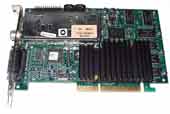
1999 - the 3dfx Voodoo3 3500 TV offered similar hardware features like the All-In-Wonder but was eventually let down by poor on-going software support.
With TV tuners for the computer now being much easier to use and cheaper than before, such as Digital TV tuners or streamlined analogue TV tuners which no longer required cumbersome audio cable hookups and which contain hardware to assist to convert the television signal into MPEG-2 video or DVD, demand for combo products was reduced and with vendors recognising the challenges faced to support devices such as the All-In-Wonder, these were discontinued in 2006.
On 26 June AMD re-introduced the All-In-Wonder to capitalise on its former glory as well as to herald in the mandatory introduction of digital television in the Americas. Previous All-in-Wonder products have had a number of firsts, such as one of the first to have a solid state TV tuner onboard, RF remote control, interactive TV guide, and integration of GPU and TV tuner.
The new All-In-Wonder HD feature set is the most impressive combination product to market so far allowing a wide range of flexibility with different types of video connections for both input and output as well as digital tuning but further investigation reveals that the tradeoff for integration of television features is a slower and less powerful Graphics processor in the product.
While the All in Wonder HD includes a mainstream class ATI Radeon HD3650 GPU [which was announced in Jan 2008] which sports support for the latest technologies such as onboard Blu-Ray disc decoding, DirectX 10.1 Graphics and high fidelity, high quality gaming, at an affordable price and ATI's highly regarded Theatre 650 chipset for TV tuning, some necessary comprises have been taken to ensure the all-in-wonder is a good balance of feature and performance.
The Radeon HD3650 GPU on display only add-in-boards typically runs at 600Mhz Core speed, with 128-bits wide GDDR3 video memory running at 800Mhz.
The same GPU integrated into the AIW HD product runs at 725Mhz Core speed with 128-bits wide DDR2 video memory running at 600Mhz, however frame buffer that is video memory provides is 512MB. While DDR2 memory technology is a cheaper and slower technology than GDDR3, it is more mature meaning higher densities are available which is handy for highly integrated products such as the AIWHD.
To make up for the memory selection, ATI bumped up the frequency at which the GPU operates to offer some more graphics horsepower to make up for the lower bandwidth of the DDR2 memory used in the product. It also helps make the whole multimedia experience that the product offers somewhat smoother.
Tradeoffs with the graphics solution in All-in-Wonder products are not new and this is acceptable given the nature of the product. However due to cost of development and market forces, ATI will not be offering a version for the All-in-Wonder HD for markets which use PAL or DVB-T television signals, which includes most of Europe, Asia, South America and whole of Australia/New Zealand.
Users in these regions will either have to purchase the TV Wonder™ or a third party TV tuner solution
Additionally AMD has made available several accessories for the product which enhance its video capture and video output capabilities and these are available as optional extras. We feel that this expansion card and cable set should be included with the product without question, even if the price would need to be increased to cater for these parts.
It is unfair to the customer and user to purchase a product with partially implemented capabilities and up-sell/value add off the customer by charge at additional cost to provide the pieces to complete these already implemented features.
AMD wants these markets to purchase their PAL/DVB-T 'Euro' version of TV 650 product which is a standalone TV tuner for PCI or PCI express slots.The use of a Radeon Graphics board and a standalone TV tuner offers similar functionality to the All in Wonder but that product still offers more video flexibility.
New computers also contain a mixture of expansion slots and space is at a premium, unlike the last decade where computers contained 4 to 6 of the same type of expansion slots [PCI]
The new product includes a Radeon HD3650 GPU with 512 Megabytes of video memory, a Digital TV Tuner for the American marketing featuring Over the Air and Cable reception for NTSC, ATSC and QAM signals, FM radio tuning, a remote control, numerous combinations of video output and input via the HDMI, DVI, VGA, Component, S-Video and Composite video connections.
Software support is provided with full Personal Video Recorder functionality, Windows Media Center integration, DVD authoring and AMD LIVE media streaming. Windows Vista is fully supported by this product (as well as Windows XP).
Further Reading
http://ati.amd.com/products/aiwhd/index.html
http://ati.amd.com/products/tvwonder600/pcie-euro/index.html
Creation of the Symbian foundation heralds a major push towards bringing the concept of an open-source mobile phone operating system to the mainstream
In the mobile/smart phone market of recent years, products have been featuring a number of second or third party operating systems tailored to the needs of the manufacturer rather than a bespoke solution developed specifically for a particular product line or model.
As is the case on a personal computer, the software is much more important than the hardware and by using a feature rich operating system, a vendor of mobile computing products can offer products that are flexible, dynamic, configurable and can be updated or expanded upon after sale by means of software updates or third party applications or games.
Since 2002 when this concept of a computer like operating systems for mobile computing [especially phones] that was loosely coupled to the hardware was first touted, users have had a number of solutions to choose from and comprise as follows
- Apple OS X [Based on Darwin BSD, used by Apple iPod and iPhone ]
- Research-In-Motion Blackberry
- Linux [Motorola and Nokia N800 series Internet tablets ]
- Microsoft Windows CE, later Windows Mobile [on HTC smart-phones, Motorola, Samsung, Palm, various Navigation devices and other smart-phones]
- Palm Operating System
- Symbian Operating System [which was ported by Nokia as Series 60, UIQ by Sony-Ericsson and Motorola, and MOAP-S for the NTT DoCoMo Japan system]
Either of these operating systems gave the user a wide choice of configuration options, flexibility in the way the user could navigate and use the device via means of intuitive software controls and allowed for the installation or use of third party applications which can either be installed via a disk storage medium or via the Internet.
Of these operating systems,Windows CE and Palm (and more recently, OS X) have been marketed heavily and the fact these operating systems remain exclusive, with a few exception to particular hardware platforms makes these operating systems an attractive bullet point for sales and marketing purposes.
The Symbian operating system is the one which is less known to users as there the core operating system has been ported and customised by a number of vendors such as Nokia, Sony-Ericsson and Motorola for their own purposes with focus on the User Interface and hence there is no single mobile operating system that is truly the Symbian Operating system, just as there has been many versions Microsoft Windows over the years and there no longer is a single operating system called UNIX but there are many UNIX and LINUX derivatives.
All this is about to change however.
On June 24 2008 an announcement was made by Symbian and its partner mobile computing vendors which would dramatically change the way mobile computing is perceived and used.
It was proposed that these existing shareholders of relinquish and sell their shares in Symbian Limited to Nokia who would form a new organisation called the Symbian Foundation whose purpose was to evolve the Symbian OS into a royalty free open source operating system to be adopted by the major players in the mobile phone and mobile computing segments.
This announcement benefits current users, future customers and vendors in a number of ways.
- Current users can be confident that operating system in their expensive mobile phone is not a dead end
- Future customers can except devices that are more feature rich and dynamic than present, and with reduction of royalties and streamlining of development costs prices, as well as an increased number of devices with similar software and features prices will fall. If the user is a developer or enthusiast they will have a wide scope to modify the software themselves.
- Vendors can reduce their R&D costs by deploying an open source operating system while at the same time they can still value add to this operating system by implementing features exclusive to company. Membership of the Symbian Foundation will only be a low $1,500 USD fee
This consolidation amongst competitors was also eventually required for additional reasons.
The Symbian Foundation expects that by 2010, four billion people will be connected by mobile phones and for many of these people their first online, Internet experience will be through a mobile device rather than a traditional computer/Internet terminal. Mobile phones in general, including smart-phones have not changed much in terms of user interface for ten years.
The paradigm is still the same, comprising of a 12-key alphanumeric keypad; a display of varying size and specification and some navigation and a small number of control keys, often called 'soft keys' due to the fact that their function varies depending on what screen, or page the user is viewing.
The user is still faced with a multitude of nested menus and restricted control systems that allow only for limited movement. The human interface design of a typical modern mobile phone is really no different from a twenty year old pocket calculator. More keys or more intuitive user controls have helped ease of use and interaction but these only really change the 'glue' between the hardware and software.
There have been some imitative taken by the major players in the mobile computing industry such Nokia, Sony-Ericsson and Apple bringing full touch controls and pen input to these devices, dramatically improving ease of use with users no longer being restricted to up-down-left-right and having freedom of use.
Of these firms, Apple has been practically the only one which has succeeded in bringing a new paradigm to mobile computing by starting from scratch - Apple OS X for iPhone is a flexible, dynamic, intuitive and feature rich operating system with little restrictions on how the user operates the device.
As this firm is rapidly gaining market share, its competitors realised that while they had the technology to match, the drive was not there so it seems to have been a classic case of ' anything you can do I can do better' and through collaborating and making Symbian Operating System open and 'free', it has now become a true threat to other solutions in the market and within five years could indeed posed a significant market share.
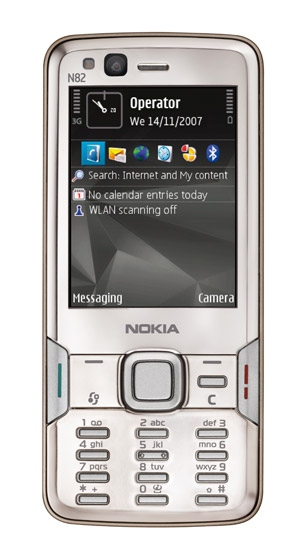
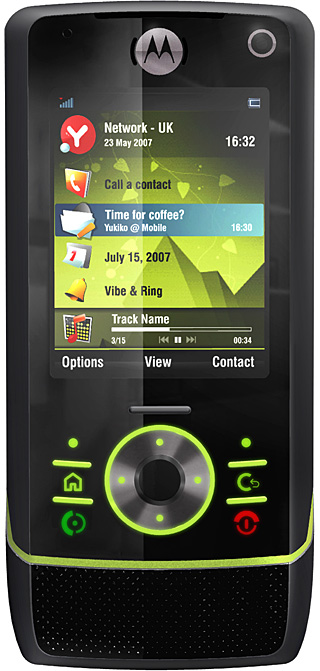
Compare the 'home screen' of these two phones - on the left is a Nokia N82 which uses Symbian Series 60 operating system with Feature Pack 1, on the right is a Motorola RIZR Z8 which uses Symbian UIQ version 3 operating system. Notice that the home screen is very similar between these competing phones and the difference is mainly the style and theme of the user interface.
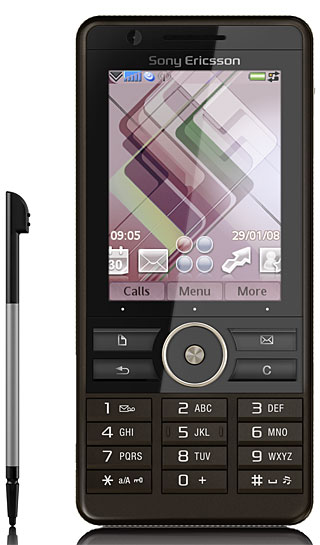
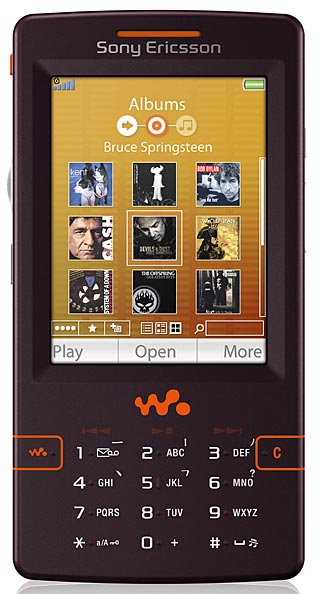
One of the existing features of UIQ's version of the Symbian operating system is the labels are presented for three 'soft keys'. Both the Sony-Ericsson G900 on the left and W950 Walkman phone on the right have this feature, which was not enabled by Nokia until the release of their Symbian OS - Series 60 Version 3 with Feature Pack 2 which is only used on a very small number of handsets such as the new Nokia N78 and N96. However, users can still use the middle key such as on their D-Pad or navigation control.
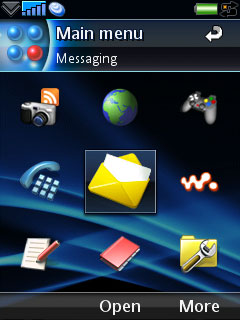
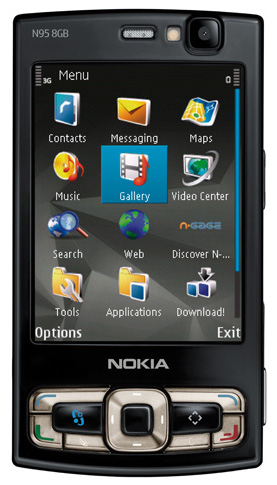
The Left screencap is from a Sony-Erricson 'Walkman' phone which uses Symbian-UIQ while on the right we have the popular Nokia N95-8GB handset which uses Symbian-Series 60 version 3. In concept the screens are the same because the underlying operating system is the same, but navigation varies. UIQ handsets typically use nine icons per screen with more/back navigation controls while Series 60 handsets now feature twelve icons per screen-full.
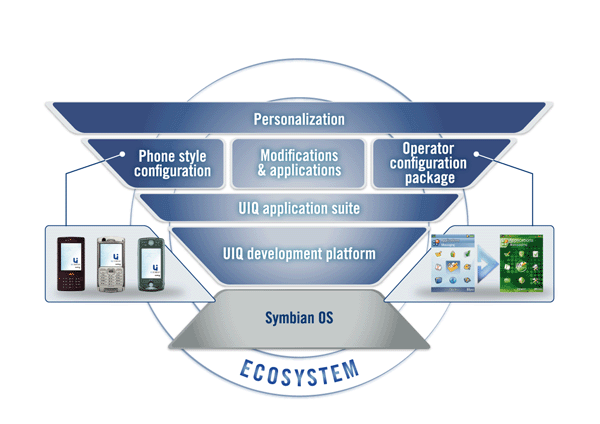
Further Reading
Symbian Foundation Web site http://www.symbianfoundation.org/
Symbian Foundation White-Paper http://www.symbianfoundation.org/files/WhitePaper.pdf
UIQ Technology - Phone lineup http://www.uiq.com/uiqphones.html
 Creative Labs Pty Ltd [Australia] have announced availability of their HN-605 Noise-Cancelling headphones which are available now from major Australian retailers for a RRP $69.95 incl GST.
Creative Labs Pty Ltd [Australia] have announced availability of their HN-605 Noise-Cancelling headphones which are available now from major Australian retailers for a RRP $69.95 incl GST.
 ZOTAC, a NVIDIA add-in-board partner now provides five years warranty on newly purchased graphic cards in Australia on the provision of ‘no physical damage’ yet does not assure customers that they will be looked after if there is capacitor failure.
ZOTAC, a NVIDIA add-in-board partner now provides five years warranty on newly purchased graphic cards in Australia on the provision of ‘no physical damage’ yet does not assure customers that they will be looked after if there is capacitor failure.
Inclusion of desirable and emerging wireless networking solutions as built in features for a laptop allows for mobile computing users to enjoy increased freedom.
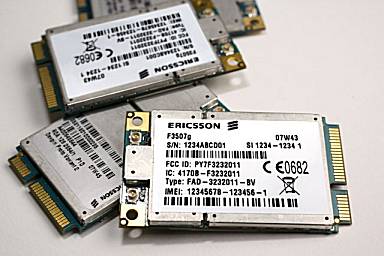 Starting Quarter 2, 2008 DELL will be offering mobile broadband modules as build to order options on their laptop product offerings. These modules, supplied by Swedish communications expert Ericsson allow a user to have high speed broadband Internet access and GPS based location, navigation capability right in their laptop without having to use or carry around additional peripherals.
Starting Quarter 2, 2008 DELL will be offering mobile broadband modules as build to order options on their laptop product offerings. These modules, supplied by Swedish communications expert Ericsson allow a user to have high speed broadband Internet access and GPS based location, navigation capability right in their laptop without having to use or carry around additional peripherals.
Currently, for a use to achieve GPS functionality, a specialist notebook such as a Panasonic Toughbook purchased which has built in GPS or a dedicated GPS receiver which connects to a computer via a USB cable would be purchased.
Specialist notebooks/laptops are not for everyone and dedicated GPS receivers can be costly , especially if acquired with bundled software or map data. Additionally since these devices are external peripherals, the user must find some way to mount the GPS receiver, wether its on a desk, car window or stuck to the laptop display itself. These are not elegant solutions and may hinder mobility as well as GPS reception. Built in GPS functionality into a laptop is transparent to the user who only need to ensure the device drivers and software is installed and functioning.
The international specification of 3G cellular networks is now commonplace around the world and many users are taking advantage of its broadband class speeds and using 3G as a wireless broadband solution for their computing needs. Typically a cellular network will offer its customers a branded 3G modem in the form of a PCMCIA/ ExpressCard adapter or a USB dongle, often nicknamed a 'lozenge' by the technology press due to the devices shape. '3' and Vodafone offer the 'lozenge' USB adapter bundled with a data plan and are switching to a more streamlined device however even this new model is still a hindrance to use when plugged into the side of a laptop computer.
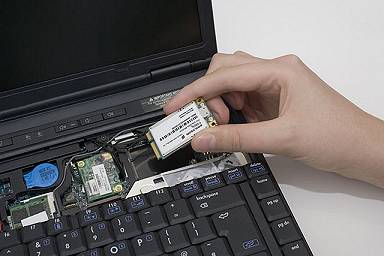 Again, not only are these devices external to the computer and are a hindrance but they are an added cost to the consumer.Even though these modems are subsidised by the provider, the user is required to sign up to a separate data plan specifically for the 3G solution even if they already have subscription to a data/voice plan.
Again, not only are these devices external to the computer and are a hindrance but they are an added cost to the consumer.Even though these modems are subsidised by the provider, the user is required to sign up to a separate data plan specifically for the 3G solution even if they already have subscription to a data/voice plan.
Purchasing a WWAN (wireless wide area network) module such as what DELL/Ericssson are offering improves mobility with no external dongles or adapters to worry about breaking, the solution is transparent to the user who only needs to insert their SIM card into the laptop, saves purchase cost to the user by owning an unlocked [to the cellular provider] 3G modem which installs internally to the laptop and by choosing a model with dual functions such as 3G/GPS [or Wi-Fi and Bluetooth] users get added functionality for their spend.
3G functionality has been available in some laptops for a while now but this has been mainly concentrated on the American market who typically do not use the International 3G standard. This announcement applies to the worldwide 3G/3.5G wireless networks with HSPDA or HSPA, which make up 85% of the worlds wireless networks.
HSPA [High Speed Packet Access] is often called 3.5G wireless and is the worlds most deployed mobile broadband technology according to Ericsson. HSPA is an extension to 3G [WCDMA and GSM] networks and can scale up to 42Mbits down ands 12Mbits up and can operate with any of the existing frequencies that are deployed by 3G networks worldwide who use WCDMA/GSM technology.
The Ericsson Mobile Broadband Module is designed and manufactured by Erisccson and supports HSPA[high speed extension for 3G], EDGE [a high speed extension for 2G], GPRS [often called 2.5G, this is the main international method of wireless access for mobile devices which are not 3G] and GSM [which is standard 2G cellular wireless without any speed enhancements]
For HSPA the adapter will offer 7.2Mbits down and 2Mbits up which is equivalent to an external solution.
In Australia, Telstra offer up to 7.2Mbits via their NextG network using this 3.5G HSPA wireless technology and promise to scale their speeds up to the promised 40Mbits within a number of years. Other providers such as Vodafone and Optus have announced upgrade plans to improve the throughput of their networks.

3.5G network speeds vary from 3.6MBits, to 7.2Mbits, to 14.4Mbits and beyond through to 40Mbits by about 2010 and beyond where Ericsson also projects 71% of mobile connections will be via HSPA and 50% of notebooks will ship with this wireless technology built-in.
Throughput is dependant on a number of conditions such as signal strength, network congestion, network capacity and device support.
Telstra Bigpond claim to have Australia's only 3G 14.4 mbit network and that customers will typically experience 550kbps to 3mbits, which represents the maximum out of a 3.6mbit 3G with HSPDA device. In dense areas users can acheive 6mbits. While Upstream speeds are 384kbits, 6mbits is the realstic maximum from a 7.2 mbits wireless device due to effiency and overheads. Telstra Bigpond offer 7.2 mbit modems in a variety of form factors as an option to customers.
Vodafone Australia claim that 500kbps to 1500kbps is acheiveable on their network,however recent annoucements to the industry point to an capacity upgrade of their network.
Further Reading
Quick Links for Notebooks with built in or build to order option for 3G wireless - Australian Region.
Dell Inspiron 1525 and XPS M1330 with built in 3G, avalible with Telstra Bigpond Wireless or Vodafone data plans
http://www.dell.com.au/vodafone
http://www1.ap.dell.com/content/topics/topic.aspx/ap/topics/microsite/en/bigpond_broadband?c=au&cs=audhs1&l=en&s=dhs">http://www1.ap.dell.com/content/topics/topic.aspx/ap/topics/microsite/en/bigpond_broadband?c=au&cs=audhs1&l=en&s=dhs
Lenovo Thinkpad with optional WWAN
http://www-07.ibm.com/lenovoinfo/au/thinkpad/vodafone.html
HP nc6400 business notebook
http://www.hp.com.au/broadbandwireless
Toshiba Portege R500 and Tecra M9 with built in 3G avalible with Telstra Bigpond Wireless plan
http://www.toshibanotebook.com.au/index.html
Ericsson Wireless Broadband Modules
http://www.ericsson.com/solutions/mobile_broadband_modules/press.shtml
Hitachi have announced a new high capacity and high performance hard drive in their line-up of solutions for enterprise servers, which offers a significant increase in storage capacity over existing 146GB and 300GB drives in that market segment
The new drive, the Ultrastar 15K450 offers a claimed 30% improvement in throughput rates of seek times of 3.3ms.
As this drive is intended primarily for front-line server use, it features either a 3 Gigabit per second Serial Attached SCSI (SAS) Interface or a 4 Gigabit per second Fibre Channel interface.
With a spindle speed of 15,000 RPM such a drive requires adequate air distribution, filtration and cooling. Aspects of this design requirement are visible in images of the drives internals, noticeably the number of air filters and air channels to manage air flow and air pressure. These features also provide a degree of damping which can counteract transmission of vibration from the very high speed rotating platters into the system chassis or transmit vibration to other disk drives.
Drive heads are parked in what Hitachi says is a patented ramp solution. When not in use, such as when the drive is off or in a low power state, the read/write heads are unloaded and moved over and parked in this ramp which protects the fine heads from damage improving drive reliability as well as protecting the disk platter and the users data which is contained on these platters by minimising the possibility of heads crashes when the drive is not in use, such as when the drive is being moved.
A head crash is termed as when a head [which is located on the tip of the metal arms visible in the photograph below] collapses and falls onto the disk platter, resulting in physical damage to both the platter and the head assembly resulting in data loss.
Disk platters may either be metal typically aluminium or glass with a magnetic coating, a technology which IBM (now Hitachi) pioneered.
Smaller platters are easier to make rotate faster, they also vibrate less, and also they are easier to stop and spin again because they are lighter so inertia is less
Those familiar with desktop 3.5 inch form factor hard drives may find the sight of the smaller diameter disk platters in this drive [and other high performance drives] a bit unusual. There are a number of reasons that smaller platters are used in high speed disk drives.
Smaller platters require less effort to reach their operational rotation speed than larger platters. This means that larger voice coils [the motor that spins the disk platters] are not required, and therefore power consumption and electrical circuit design are kept optimal.
Since this class of drives has an operational rotational speed of 15,000 RPM, vibration becomes an important issue to manage for the drive's own mechanicals and electronics, transmission through the system chassis and possible side effects on other components that are installed in the system chassis. Smaller platters, in addition to clever design of the HDD chassis aid in management of vibration.
Smaller platters offer faster seek times as the drive head does not have to physically move as far across the platter to access the desired data. In addition smaller platters are lighter so their inertia is less, resulting in quicker start stops and faster seeks. Fast seek times, especially average seek times are a requirement of server class hard disk drives, meaning data is located and accessed faster.
Full drive technical specifications are available at HGST's web site.
At time of going to press, unit pricing was not available. The 15K450 will ship this quarter.

Motherboard maker DFI, primarily known for their enthusiast 'LANParty' line of motherboards has issued a statement advising consumers to be aware of unauthorised motherboards re-branded as DFI primarily in Indonesia.
DFI say that the two motherboards in question, an NVIDIA MCP73 based solution for the Intel Socket 775 Processor and an NVIDIA MCP68 based solution for the AMD Socket AM2+ processor are not sourced from or manufactured by DFI and that consumers should be aware of this, as no support can be offered to owners of this counterfeit products.


NitroWare.net notes that in both cases a telltale is that the DFI logo on the boxes of the counterfeit product is not an accurate reproduction of DFI's registered marks an accurate match.
The lettering on the counterfeit boxes is much heavier than the typeface used on official DFI materials.
Additionally, the box-art for the MCP68V product represents another product not the product for sale. This is evident in photos supplied by DFI.
DFI has also provided a quick reference chart to identify currently available official DFI products.
Both counterfeit products are based on common reference designs so the exact origin can be difficult to determine.
We remind Australian readers to be mindful of counterfeit motherboards from Indonesia especially at swap meets or un-familiar stores. If in doubt, enquire about authenticity or shop elsewhere
Typically for products available for sale in Australia via legitimate channels, there shall be some identifying marks such as supplier details on the packaging.
For photos of the counterfeit products in question and of legitimate products, view DFI's press release.
NitroWare.net will be following up this story in due course.
While Solid State Drives (SSD) have been available as a build-to-order option on notebooks for around a year now, their price and relatively small capacity compared to traditional hard disk drives has meant that these devices have not been a compelling choice for majority of potential customers.
As of April 2008, Apple's Macbook Air notebook with the 64GB SSD and 1.8GHz processor with commands a $1409 AUD premium over the 80GB HDD 1.6Ghz configuration.
Some customers may not see the justification in paying more money for less storage space [SSD are faster and quieter].
The 2133 Mini Note from HP is also available with a SSD as are products from DELL, although only of 64GB capacity.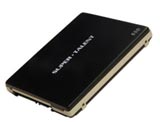
Larger capacity drives comparable to the sizes of traditional 2.5" HDDs shipping in mainstream notebooks such as those in the 120GB-320GB capacity range would be a more compelling choice for those customers considering a Solid State disk option at time of purchase.
Super Talent Technology Corporation is now shipping a 256GB 2.5" SSD with a SATA interface which they claim is the worlds thinnest 256GB SSD in that form factor with read speeds of up to 65MB/s and write speeds up to 50MB/s.
Well suited for industrial and commercial applications, the FSD56GC25H is now shipping to Original Equipment Manufacturers (OEMs).
For the benefit of end users and vendors we hope that the technology and engineering used to develop large capacity SSD drives such as this one is put to further use enhancing SSDs for mainstream and consumer adoption. End user and vendor take up of this technology should improve providing that the price-point for larger capacity drives represents value for money.
Creative Labs annouce an updated release of their feature packed ZEN media player but with a new control mechanism, touch pad replaces the side mounted jog wheel on the original 2002 release of the ZEN
The design, touchpad, battery life and pricepoint are competitive with the Apple iPod.
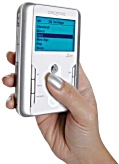
CREATIVE ZEN TOUCH Portable Audio Player Features Ultra-cool Vertical Touch Pad Scrolling and Patented Technology Achieving up to 32-hour Battery Life*
Find your favorite songs with a touch and a drag of your finger
SYDNEY - AUGUST 2, 2004 - Creative Labs Pty Ltd, local subsidiary of Creative Technology Ltd (NASDAQ: CREAF) a worldwide leader in digital entertainment products for PC users, today introduced the Zen Touchââ??¢, a 1.8-inch hard drive-based portable audio player that holds up to 10,000 songs in WMA format or 5,000 songs in MP3 format. Available at the end of August 2004, the Zen Touch comes with a 20GB hard drive and includes an extra bonus, FM-wired remote control currently retailing for AUD$149.95 inc GST. The recommended retail price of the Zen Touch will be at AUD$499.00 inc GST which includes the bonus FM-Wired Remote.
The Zen Touch features the innovative patent pending "Touch Pad" control, which allows users easier access to their musical selections. The face of the player also features a dedicated "Random" button for spontaneous music playback of any combination of songs.
"The Zen Touch is so easy and fun to use because the touch pad allows the user to find their favorite songs with a touch and drag of their finger on the touch pad in a natural, vertical motion. This makes it more intuitive than a circular motion in locating songs, or you can just hit the random button for a mix of music to match any mood," said Sim Wong Hoo, Chairman and CEO of Creative Technology Ltd. "Plus you can take the Zen Touch on long trips and leave the power cable at home without worrying about the rechargeable battery running out too soon."
Equally as cool-looking as it is feature-rich, the metallic graphite and white gloss-coloured Zen Touch displays track and menu information on its large, brilliant blue backlit LCD screen and boasts a handy "Find" feature so that you get to your favorite music in no time. In addition to its groundbreaking battery life and super-intuitive user interface, the Zen Touch provides industry-leading audio quality and broad compatibility with the legal download music services supporting the secure WMA music format. Crystal-clear high fidelity playback at 97dB SNR can be customized with a four-band graphic equalizer with eight equalization presets. USB 2.0 connectivity enables fast music transfer from a PC as quickly as a song per second.
Zen Touch incorporates a patented technology that significantly extends its battery life up to 32 hours (*based on MP3 48Kbps compression rate). Even on more power-hungry high-quality music of 128Kbps compression, its battery life is still impressively over 24 hours (using fresh batteries).
Exclusively previewed by Microsoft at the 2004 WinHEC event, the Zen Touch was showcased as the first player to support upgrades to the next generation of Windows Media Digital Rights Management (DRM) technology, a platform for providing exciting new subscription models for content download.
"With its exciting new device, the Zen Touch, Creative sets a new bar for battery life and provides music fans a broad choice of music services accessed within Windows Media Player," said Jonathan Usher, director of the Windows Digital Media Division at Microsoft Corp. "The Zen Touch is the first in a new line of products from Creative that will support our next generation Windows Media DRM, enabling new playback scenarios for subscription-based or on-demand digital music."
The new Creative Zen Touch 20GB, priced at AUD$499.00 inc GST is slated for shipping in August 2004. The ultra-portable audio player comes with a black protective case, Neodymium headphones, a USB 2.0 cable, and a universal power adapter, PLUS FM-Wired LCD Remote control currently sold as an accessory for AUD$149.95 inc GST. The player also includes Creative MediaSourceââ??¢, an easy-to-use application for ripping CDs, organizing entire digital music collections, and easily transferring MP3 and WMA files.
For more information about Creative portable audio players, please visit www.australia.creative.com
* 32-hour battery life rated when using fresh battery running 48Kbps MP3 music continuously.
About Creative Labs Pty Ltd
Creative Labs Pty Ltd started operating in Australia back in February 2000 and is a wholly owned subsidiary of Creative Technology Ltd. Just recently, Creative Labs expanded its operation to a new showroom and office situated on busy Parramatta Road in Sydney. The new address is Shop 3-5, 524 Parramatta Rd, Petersham NSW. Telephone: (02) 9021 9800.
Creative (NASDAQ: CREAF) is a worldwide leader in digital entertainment products for PC users. Famous for its Sound Blasterââ??¢ sound cards and for launching the multimedia revolution, Creative is now driving digital entertainment on the PC platform with products like its highly acclaimed NOMADÃ?® Jukebox MP3 player. Creative's innovative hardware, proprietary technology, applications and services leverage the Internet, enabling consumers to experience high-quality digital entertainment -- anytime, anywhere.
This announcement relates to products launched in the Asia Pacific. The product names, prices and availability are subject to change without notice and may differ elsewhere in the world according to local factors and requirements. Creative, MediaSource, and Sound Blaster are trademarks or registered trademarks of Creative Technology Ltd. in the United States and other countries. NOMAD is a registered trademark of Aonix and is used under license.
This seems to be an industry first. Traditionally the host based audio CODEC or controller manufacturers have licensed algorithms from vendors of discrete solutions or software houses, Eg, EAX from Creative, A3D from Aureal, Sensaura from Sensaura and Dolby Digital from Dolby Labs.
In this case, Creative will provide a software based feature rich upgrade for systems which feature Analog Devices host based audio. While it is impossible to upgrade the hardware audio CODEC, this new software upgrade can provide end users with a better audio experience, both quality and feature wise.
Exact features were unavalible at time of writing.
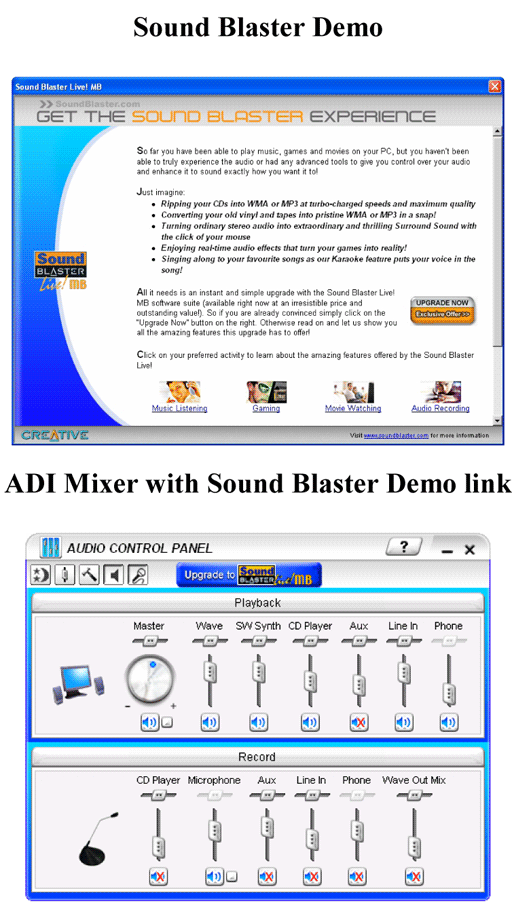
CREATIVE AND ANALOG DEVICES ANNOUNCE AGREEMENT TO ENABLE CREATIVE TO EASILY UPGRADE THE PC FROM HOST AUDIO TO SOUND BLASTER QUALITY
Sound Blaster Integrated Audio Upgrade Delivers Rich Features, Simple End-User Experience.
SYDNEY July 26, 2004 - Creative Labs Pty Ltd, a local subsidiary of Creative Technology Ltd (NASDAQ: CREAF) the creator of Sound Blaster® which is the worldwide standard for high quality PC audio and leader in digital entertainment solutions, today announced an agreement with Analog Devices Inc. (NYSE: ADI) that allows Creative to provide PC users with a simple upgrade from host audio to Sound Blaster audio quality.
Under the agreement, Creative will market a Sound Blaster-enhanced audio upgrade to Analog Devices' integrated audio. This will allow end users to enjoy the Sound Blaster experience on products from many PC OEMs and motherboard manufacturers who use audio chips from market leader, Analog Devices. This experience includes state-of-the-art audio such as voice-enabled applications, enhanced music experiences, home theater-quality DVD movies, and next-generation game audio.
In addition to providing an upgrade to Analog Devices' large customer base, Creative will market a complete family of audio accessories directly to end users. The Creative upgrade solutions and accessories are slated for availability worldwide at the end of 2004.
"We are excited to provide Analog Devices' huge customer base with an easy, low-cost upgrade path to Sound Blaster audio quality," said Steve Erickson, vice president of the audio group for Creative. "For the first time in history, users of motherboard audio can enjoy the great audio quality and feature rich enhancements of the Sound Blaster brand by purchasing an easy and simple to install upgrade."
"As the market share leader in PC motherboard audio, we're thrilled to enable Creative's leadership products, technology and brand in mass-market motherboard configurations," said John Croteau, general manager, Media Platforms and Services Group, Analog Devices, Inc. "This is an important expansion for integrated audio features since the up-sell model for upgrades and accessories today drives the retail and direct-order PC channels with the profit opportunities often exceeding those of the PC itself."
ADI in PC Audio
Analog Devices today holds more than 50 percent market share in motherboard audio subsystems. The company's high-performance audio codecs ship in major brand motherboards and PCs from manufacturers including ASUS, Dell, Fujitsu-Siemens, HP, IBM, Intel, NEC Sony, and Toshiba.
For more information about please visit our website at www.australia.creative.com
About Creative Labs Pty Ltd
Creative Labs Pty Ltd started operating in Australia back in February 2000 and is a wholly owned subsidiary of Creative Technology Ltd. Just recently, Creative Labs expanded its operation to a new showroom and office situated on busy Parramatta Road in Sydney. The new address is Shop 3-5, 524 Parramatta Rd, Petersham NSW. Telephone: (02) 9021 9800.
About Creative
Creative (NASDAQ: CREAF) is a worldwide leader in digital entertainment products for PC users. Famous for its Sound Blaster® sound cards and for launching the multimedia revolution, Creative is now driving digital entertainment on the PC platform with products like its highly acclaimed MuVo® and Zen portable audio players. Creative's innovative hardware, proprietary technology, applications and services leverage the Internet, enabling consumers to experience high-quality digital entertainment -- anytime, anywhere.
About Analog Devices, Inc.
Analog Devices, Inc. is a leading manufacturer of precision high-performance integrated circuits used in analog and digital signal processing applications. ADI is headquartered in Norwood, Massachusetts, and employs approximately 8,700 people worldwide. It has manufacturing facilities in Massachusetts, California, North Carolina, Ireland, and the Philippines. Analog Devices' common stock is listed on the New York Stock Exchange and ADI is included in the S&P 500 Index.
Doom 3 to be bundled with Videomax brand ATi Raedon graphics cards.
Our staff have sighted advertising posters at several Sydney Electronics Boutique (EB) stores, emlbazoned with the slogan "Do you want Doom 3 for free?" indicate that Doom 3 will be bundled with Videomax brand ATi Raedons.
Videomax brand graphics cards are distributed in Australia by BCN Technology Pty Ltd and are sourced from CP Technology.
BCN/Videomax press release 2 March 2004Videomax product line
No further details regarding the EB Doom 3 Raedon bundle were avalible at press time.
Parking is avalible in area P6F and there will be lots of prizes and giveaways.
Experience the latest in graphics, computing technology and gaming.
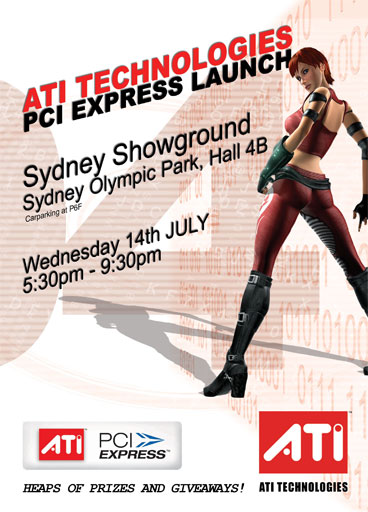
Crucial Technology and Micron annouce PC2700 double data rate (DDR) synchronous DRAM (SDRAM) at an increased clock speed of 166Mhz to end users.
CRUCIAL AND MICRON PROVIDE PC2700 DDR SDRAM TO THE UPGRADE MARKET
Meridian, Idaho, April 16, 2002 - Starting today, Crucial Technology(R), a division of Micron(R) and one of the world's largest direct memory upgrade providers, is offering Micron's high-quality PC2700 double data rate (DDR) synchronous DRAM (SDRAM) to end users.
The new, higher-speed memory upgrade modules are immediately available to Crucial customers in 128MB and 256MB densities through the Crucial Web site at Crucial.com.
"Customers shopping for high-speed, cutting-edge memory technology like PC2700 DDR want to know they're getting a product they can trust," said Crucial Technology General Manager Mike Bokan. "At Crucial, our customers know they'll always get the highest quality memory available backed by Crucial's excellent service and support."
"The ability to provide PC2700 DDR modules to the end user through Crucial demonstrates our commitment to bring DDR memory technology to the mainstream," said Micron DRAM Products Strategic Marketing Manager Brett Williams. "In the end, the consumer benefits from the connection between Crucial's direct business model and our high-volume manufacturing capabilities."
PC2700 operates at 167MHz with a 333MT/s data rate and is currently the fastest generation of JEDEC-approved DDR SDRAM available. JEDEC is the semiconductor engineering standardization body of the Electronic Industries Alliance (EIA).
Crucial 128MB PC2700 CAS 2.5 modules for DDR333-compatible motherboards are initially available for US$57.59 and 256MB are US$111.59. The modules are offered to consumers through Crucial's Web site at www.crucial.com and to hardware developers through Crucial's DDRevolution program. This program offers qualified developers and system builders preferred product allocation and volume discounts on Crucial DDR SDRAM. For more information about the Crucial DDRevolution Program and how to become a qualified member, visit http://www.crucial.com/DDRevolution.
Crucial Technology is a division of Micron Semiconductor Products, Inc., which is a wholly owned subsidiary of Micron Technology, Inc. Crucial sells memory upgrade modules direct from Micron and offers over 94,000 upgrades for more than 15,000 desktops, notebooks, servers, routers, printers, and electronic devices. Visit http://www.crucial.com to learn more about Crucial.
Micron Technology, Inc., and its subsidiaries manufacture and market DRAMs, very fast SRAMs, Flash Memory, other semiconductor components and memory modules. Micron's common stock is traded on the New York Stock Exchange (NYSE) under the MU symbol. To learn more about Micron Technology, Inc., visit its web site at www.micron.com.
Symantec have announced their popular Norton SystemWorks and Internet Security applications for OS X, now if only Symantec would port these applications to Linux each major operating system would have equivalenet security and maintence applications.
Symantec Announces the First Complete Line of Internet Security and Problem Solving Products Designed Specifically For Mac OS X.
New Versions of Norton Internet Security and Norton SystemWorks to Provide Macintosh Users Improved Online Safety,Enhanced Disk Repair and Recovery Capabilities.
Sydney, Australia, 22 March, 2002 - Symantec Corp. (Nasdaq: SYMC), the world leader in Internet security, today announced the industry's first complete line of Internet security and problem solving products designed specifically for Mac OS X.
The release includes Norton Internet Security for Macintosh 2.0 which will improve Mac users online productivity, safety and privacy with the addition of a stealth protection mode, confidential information controls and Internet ad blocking features.
Norton SystemWorks for Macintosh 2.0 is the world's first product to allow users to fix disk errors and recover lost files or applications natively on Mac OS X.
Computer users who use the Internet at work or at home are becoming more and more aware of the need for comprehensive online security and are demanding the most advanced Internet security solutions, said John Donovan, Managing Director, Symantec Pacific. This new line of security products for the Macintosh is easy-to-use and introduces new features that not only addresses online security and privacy issues but also provide the most comprehensive and reliable disk repair and data recovery solutions.
Apple takes a proactive approach towards security within Mac OS X in a variety of ways, said Arno Lenior, Marketing Director, Apple Computer, Pacific. Symantec's new product line for Mac OS X builds on Apple's commitment towards security by helping to protect computers and networks at multiple entry points, and we're excited to receive their support.
New Privacy Control Feature To Safeguard Mac Users' Confidential Data Anyone connected to the Internet, regardless of computing platform, has the potential to fall prey to hack attacks, privacy infringements, intrusion attempts and damage from malicious code.
Symantec's Norton Privacy Control, a new component of Norton Internet Security for Macintosh 2.0, will allow users to keep track of specified confidential information, like social security and credit card numbers, and control what information leaves their machine over the Internet.
Additionally, Norton Privacy Control will offer an ad blocking feature that can help improve online speed and performance by blocking most Internet ads and pop-up windows. Macintosh users, like their PC cousins, are not immune to security threats, said Brian Burke, Sr. Research Analyst, Internet Security, at IDC Research.
Hack attacks, privacy infringements, intrusion attempts, and damage from malicious code can happen to anyone connected to the Internet, no matter what computing platform they choose.
In addition to Norton Privacy Control,
Norton Internet Security for Macintosh 2.0 will also include:
- Norton Personal Firewall for Macintosh 2.0 with a new stealth mode feature making Mac users invisible to hackers online. Norton AntiVirus for Macintosh 8.0 featuring a new interface and scheduling features to provide easy-to-use, proactive protection against viruses and other malicious code.
- Who's There? Firewall Advisor by OpenDoor Networks providing detailed information on intrusion attempts iClean by Aladdin Systems, for quick removal of cookies, cache and history files to further protect users' privacy. World's Only Disk Repair and Data Recovery Capabilities Built Natively for Mac OS X Norton SystemWorks for Macintosh 2.0 will provide comprehensive solutions to keep Macintosh computers working at peak performance by solving critical problems and protecting systems from viruses. This market-leading software suite will include the world's first native Mac OS X disk repair and data recovery capabilities, allowing users to fix common disk errors and recover lost files or applications. The new version will also feature Norton Scheduler, so users can easily schedule virus scans and software updates.
Norton SystemWorks for Macintosh 2.0 will include:
- Norton AntiVirus for Macintosh 8.0
- Norton Utilities for Macintosh 7.0, that can recover lost files and erased data as well as recover crashed or accidentally initialised files
- Retrospect Express Backup 5.0 by Dantz, which stores backup files on removable cartridges, DVD-RAM, compatible,CD-R/RW, MO, an external hard drive, or even on a secure site via the Internet
- Spring Cleaning 4.0 by Aladdin Systems, which completely uninstalls applications and their associated files to regain disk space and sweep away hard-to-find Internet cookies, cache, and history files
- DiskWarrior Recovery Edition by Alsoft, which scavenges hard drives for all files to allow Mac users to recover files and folders with drag and drop convenience
Pricing and Availability
Norton Internet Security for Macintosh 2.0 and Norton SystemWorks for Macintosh 2.0 are available now for an estimated retail price of $159 and $199, respectively. Symantec's new Macintosh products are available for purchase at various retail locations.
All of Symantec's new Macintosh Internet security solutions are compatible with Mac OS X.

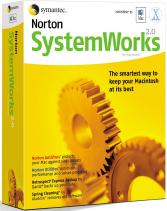
About Symantec
Symantec, the world leader in Internet security technology, provides a broad range of content and network security software and appliance solutions to individuals, enterprises and service providers.
The company is a leading provider of client, gateway and server security solutions for virus protection, firewall and virtual private network, vulnerability management, intrusion detection, Internet content and e-mail filtering, remote management technologies and security services to enterprises and service providers around the world.
Symantec'ss Norton brand of consumer security products is a leader in worldwide retail sales and industry awards.
Headquartered in Cupertino, Calif., Symantec has worldwide operations in 38 countries. For more information, please visit www.symantec.com.
CREATIVE TECHNOLOGY ANNOUNCES ACQUISITION OF 3DLABS - WORLDWIDE LEADER IN ULTRA HIGH-END PROFESSIONAL GRAPHICS
Acquisition Can Extend Leadership Into Additional Markets
SINGAPORE - March 11, 2002 - Creative Technology Ltd. (Nasdaq: CREAF), the worldwide leader in digital entertainment products for users of the personal computer and the Internet, today announced a definitive agreement under which Creative will acquire 3Dlabs Inc., Ltd. (Nasdaq: TDDD) for a combination of US$1.20 per share in cash and US$2.40 per share in Creative stock for each share of 3Dlabs.
On an approximate basis, Creative presently owns 1.8 million shares of 3Dlabs' currently issued share capital of 30.6 million shares. In addition, Creative owns warrants and convertible notes which, when exercised and converted, would provide an additional 9.4 million shares and give Creative an approximate 28% beneficial ownership of the then-total outstanding 3Dlabs shares. The cost to acquire those shares that Creative does not already own is estimated at US$34.6 million in cash and US$69.1 million of Creative stock for a total of US$103.7 million. These dollar amounts of Creative shares and cash are fixed; however, the number of Creative shares to be issued will be determined by the average closing sale price of Creative shares on the Nasdaq exchange over a ten-day period which will end five days prior to 3Dlabs' shareholder approval meeting. Based on Creative's closing price of US$13.10 per share as of Friday, March 8, 2002, this would represent approximately 5.3 million Creative shares to be issued. The total number of Creative shares issued to 3Dlabs' shareholders shall be subject to a cap of approximately 10 million Creative shares.
Completion of the transaction is subject to customary closing conditions, including approval by 3Dlabs' shareholder vote and regulatory and governmental approvals. Following completion of the transaction, 3Dlabs will become a wholly owned subsidiary of Creative.
"We have had a tremendous track record of choosing winning graphics technologies and partners over the years, and helping build them into #1 market share positions. We've helped those companies become very successful in the process," aid Sim Wong Hoo, Chairman and CEO of Creative. "As we have analyzed 3Dlabs' product lines, and most importantly their technology roadmap, we believe that their development of a scalable architecture and general purpose programmability will provide a significant competitive advantage in the graphics space."
Sim continued, "As power gamers' insatiable demand for higher performance graphics capabilities grows, we see great opportunities to expand 3Dlabs' leadership in the ultra high-end professional markets into our higher volume PC consumer desktop markets. The technological breakthroughs that 3Dlabs has achieved to date, most specifically in the design of their upcoming chipsets including the startling achievement of the world's first single chip TeraOps [trillion operations per second] visual processor with general purpose programmability, coupled with the strong market we see for high performance graphics accelerators, provide a tremendous growth opportunity for our company."
"Creative has developed, owns and markets the world's highest performance audio silicon technology," stated Sim. "With our announcement today, we will also own the world's highest performance graphics technology and a leadership position in the ultra high-end graphics space. For the first time, we will own substantial graphics intellectual property and a formidable graphics patent portfolio that will allow us to achieve a higher level of returns for our efforts as we re-emphasize the graphics category. This is a very different opportunity than when we were exclusively a graphics card provider that relied solely upon chips from other vendors. This enables us to pursue a business model that we believe has the potential for high margins like our audio businesses, while providing even more exciting opportunities for growth and enhancing shareholder value."
"We believe that this acquisition, with its many synergies and opportunities, can be accretive to our earnings in the first half of the next calendar year, excluding any charges related to the acquisition," said Sim.
"We are very excited about the opportunity provided by Creative's worldwide distribution network, huge customer base, world-famous brands, and financial resources to maximize the technology we produce," said Osman Kent, Chairman and CEO of 3Dlabs. "Integrating the resources and expertise of these two industry-leading companies can create a truly potent force in the graphics market."
Kent continued, "The timing of this acquisition is fortuitous, as we are close to releasing the most exciting high performance graphics lineup in our history. We have experienced a difficult financial period during which we continued to devote significant resources to the development of our breakthrough technologies. Creative can provide us the resources and opportunity to expand our leadership position beyond the ultra high-end graphics market. We can leverage Creative's vast experience at building global brands and market share to take full advantage of the market potential for our upcoming release of an exciting new family of graphics processors."
Creative will host a Q & A session for analysts to discuss this transaction on Monday, March 11, 2002 at 12:00 noon at Creative's headquarters in Singapore. (This is Sunday, March 10, 2002 at 8:00 PM U.S. Pacific time.) This session will also be webcast, with a link available to all investors from Creative's Investor Relations web site at http://www.americas.creative.com/corporate/investor/. A recording of the webcast will remain available at the same site for one week after the session.
About Creative
Creative (Nasdaq: CREAF) is the worldwide leader in digital entertainment products for users of personal computers and the Internet. Famous for its Sound Blaster® sound cards and for launching the multimedia revolution, Creative is now driving digital entertainment on the PC platform with products like its highly acclaimed NOMAD® Jukebox. Creative's innovative hardware, proprietary technology, applications and services leverage the Internet, enabling consumers to experience high-quality digital entertainment -- anytime, anywhere.
About 3Dlabs
3Dlabs is the workstation graphics authority, supplying graphics accelerator solutions for professionals in Computer Aided Design (CAD), Digital Content Creation (DCC), and visual simulation markets. Its award-winning Oxygen and Wildcat graphics are available in the industry's top OEM workstations, to the channel through an international distributor/reseller network, and directly to end-users at 3Dlabs' online store.Sound Blaster is a registered trademark and Live!, Audigy and Extigy are trademarks of Creative Technology Ltd. in the United States and other countries. NOMAD is a registered trademark of Aonix and is used by Creative Technology Ltd. and/or its affiliates under license in the United States and/or other countries. 3Dlabs, Oxygen, Intense3D, Wildcat ,GLINT and Permedia are trademarks or registered trademarks of 3Dlabs Ltd., 3Dlabs Inc. Ltd., or 3Dlabs Inc. in the United States and/or other countries. All other brand and product names are either trademarks or registered trademarks of their respective holder and are hereby recognized as such.
Safe Harbor for Forward-Looking Statements Under The Private Securities Litigation Reform Act of 1995:
Except for the historical information contained herein and in the corresponding analyst briefing webcast, the matters set forth herein and in the corresponding webcast are forward-looking statements within the meaning of the "safe harbor" provisions of The Private Securities Litigation Reform Act of 1995. These forward-looking statements, including statements about the accretive nature of the acquisition, are subject to certain assumptions,risks and uncertainties that could cause actual results to differ materially from those projected as a result of a number of factors, including, among others: the transaction may not close or that the companies may be required to modify aspects of the transaction to achieve regulatory approval; the technology, including the new chip, may not be as robust as expected or may not achieve the expected performance, features or yield; fierce competitive actions will be taken against Creative as Creative re-emphasizes its graphics category, including potential anti-competitive acts or lawsuits alleging intellectual property infringement; discontinuation of the supply of graphics chips from certain suppliers thereby causing a reduction of Creative's projected revenue streams from its existing graphics businesses; the possibility that 3Dlabs' intellectual property, including its patent portfolio, is not as valuable as expected; the expected accretive results will not be achieved, and revenues and margins from the graphics category will not be increased; failure to achieve the anticipated synergies; failure to effectively manage the expenses resulting from acquiring 3Dlabs; failure of the newly acquired technology to penetrate new market segments in a timely fashion, if at all, particularly the high-end graphics and the OEM markets; failure to retain 3Dlabs' existing employees; the negative impact of the continued downturn of the global stock market and overall reduction in demand for computer systems, peripherals and related products in general and Creative's products specifically, including existing and new products acquired by the transaction; and other risk factors described herein and in Creative's other filings with the Securities and Exchange Commission over the past twelve months, including without limitation, Creative's Form 20-F dated October 10, 2001. Creative urges you to consider all such factors. Creative undertakes no obligation to publicly release the results of any revisions to such forward-looking statements which may be made to reflect events or circumstances after the date hereof or to reflect the occurrence of unanticipated events.The first game demo that features the new EAX HD, EAX 3 environmental audio effects has been released.
3D Sound Surge reports that a demo of Activison/Fun Labs Secret Service - In Harms Way has been released.
Matrox G400 series card owners might recognise Fun Labs as the developer of one of Matrox's tech demo progams.
This demo features Creative EAX HD (EAX 3.0) sound effects as well as EAX2, Aureal A3D and Directsound 3D version 8
While the models and technology may not be the latest technoloogy it certainly seems an intresting title in nature and to play. We found increasing the main volume from 50 to 75 made for a better audio experience.
NitroWare.net tested the demo check to see if any additional audio effects were noticeable using a Sound Blaster Audigy sound card. Room to Room yields different levels of Reverb as well as staairs/balconies. Explosions are enhanced greatly, if you are using a subwoofer you will feel the reverb. You can hear the civilians and terrorists talking as well as outside town music to varying degrees.
We were suprised that the demo of Secret Service featured EAX HD, as Creative have announced Activision/Raven's Soldier of Fortune II: Double Helix will be the first title to support EAX HD. This is not the only game with support but was *supposed* to be the first, guess the delay of that particular title offset things. Giants has recived an EAX HD patch as well.
Some of our readers may have noticed television ads promoting this new product featuring the song Ray of Light by Madonna, but thanks to a grand launch event to be held at Super Dome in Sydney's Olympic park on this date AM more will be revealed at this event.
The event is open to all members of the public and Australia is in a unique situation - due to our timezone this region will be first to launch the product and the first in the world to access retail copies of Windows XP.


